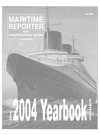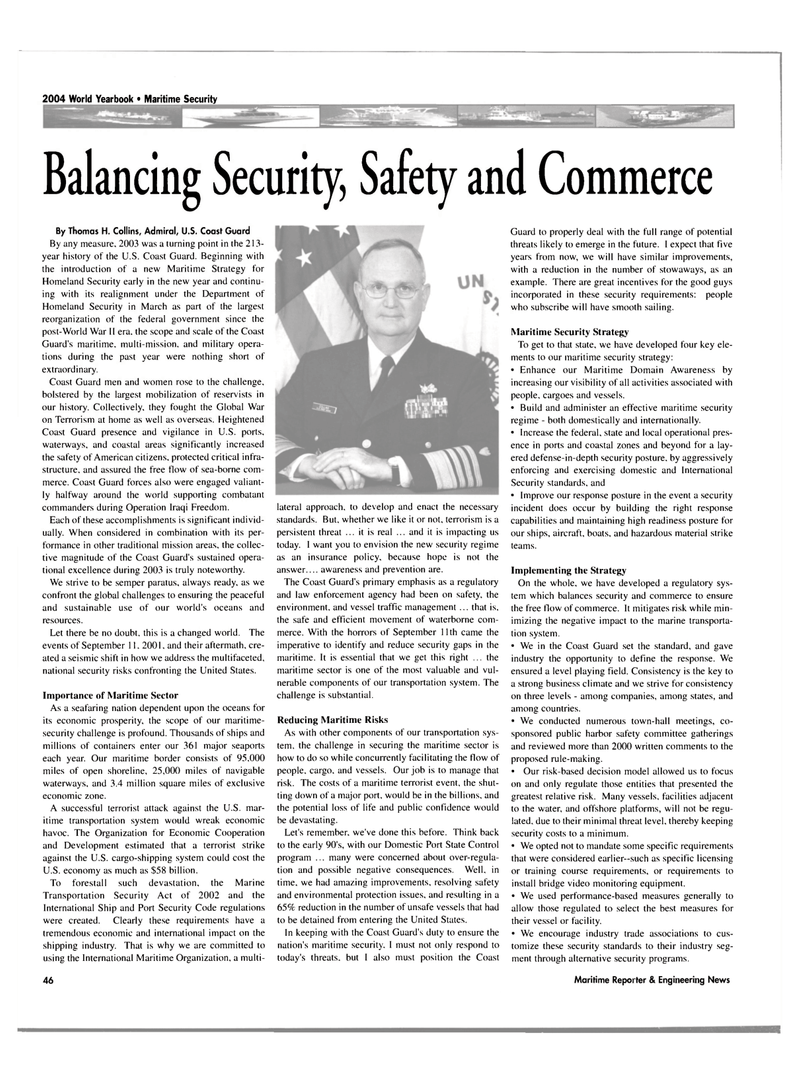
Page 46: of Maritime Reporter Magazine (June 2004)
Annual World Yearbook
Read this page in Pdf, Flash or Html5 edition of June 2004 Maritime Reporter Magazine
2004 World Yearbook « Maritime Security
Balancing Security Safety and Commerce
By Thomas H. Collins, Admiral, U.S. Coast Guard
By any measure, 2003 was a turning point in the 213- year history of the U.S. Coast Guard. Beginning with the introduction of a new Maritime Strategy for
Homeland Security early in the new year and continu- ing with its realignment under the Department of
Homeland Security in March as part of the largest reorganization of the federal government since the post-World War II era, the scope and scale of the Coast
Guard's maritime, multi-mission, and military opera- tions during the past year were nothing short of extraordinary.
Coast Guard men and women rose to the challenge, bolstered by the largest mobilization of reservists in our history. Collectively, they fought the Global War on Terrorism at home as well as overseas. Heightened
Coast Guard presence and vigilance in U.S. ports, waterways, and coastal areas significantly increased the safety of American citizens, protected critical infra- structure, and assured the free flow of sea-borne com- merce. Coast Guard forces also were engaged valiant- ly halfway around the world supporting combatant commanders during Operation Iraqi Freedom.
Each of these accomplishments is significant individ- ually. When considered in combination with its per- formance in other traditional mission areas, the collec- tive magnitude of the Coast Guard's sustained opera- tional excellence during 2003 is truly noteworthy.
We strive to be semper paratus, always ready, as we confront the global challenges to ensuring the peaceful and sustainable use of our world's oceans and resources.
Let there be no doubt, this is a changed world. The events of September 11. 2001. and their aftermath, cre- ated a seismic shift in how we address the multifaceted, national security risks confronting the United States.
Importance of Maritime Sector
As a seafaring nation dependent upon the oceans for its economic prosperity, the scope of our maritime- security challenge is profound. Thousands of ships and millions of containers enter our 361 major seaports each year. Our maritime border consists of 95.000 miles of open shoreline, 25,000 miles of navigable waterways, and 3.4 million square miles of exclusive economic zone.
A successful terrorist attack against the U.S. mar- itime transportation system would wreak economic havoc. The Organization for Economic Cooperation and Development estimated that a terrorist strike against the U.S. cargo-shipping system could cost the
U.S. economy as much as $58 billion.
To forestall such devastation, the Marine
Transportation Security Act of 2002 and the
International Ship and Port Security Code regulations were created. Clearly these requirements have a tremendous economic and international impact on the shipping industry. That is why we are committed to using the International Maritime Organization, a multi- lateral approach, to develop and enact the necessary standards. But. whether we like it or not, terrorism is a persistent threat ... it is real ... and it is impacting us today. I want you to envision the new security regime as an insurance policy, because hope is not the answer.... awareness and prevention are.
The Coast Guard's primary emphasis as a regulatory and law enforcement agency had been on safety, the environment, and vessel traffic management ... that is. the safe and efficient movement of waterborne com- merce. With the horrors of September 11th came the imperative to identify and reduce security gaps in the maritime. It is essential that we get this right ... the maritime sector is one of the most valuable and vul- nerable components of our transportation system. The challenge is substantial.
Reducing Maritime Risks
As with other components of our transportation sys- tem. the challenge in securing the maritime sector is how to do so while concurrently facilitating the flow of people, cargo, and vessels. Our job is to manage that risk. The costs of a maritime terrorist event, the shut- ting down of a major port, would be in the billions, and the potential loss of life and public confidence would be devastating.
Let's remember, we've done this before. Think back to the early 90's, with our Domestic Port State Control program ... many were concerned about over-regula- tion and possible negative consequences. Well, in time, we had amazing improvements, resolving safety and environmental protection issues, and resulting in a 65% reduction in the number of unsafe vessels that had to be detained from entering the United States.
In keeping with the Coast Guard's duty to ensure the nation's maritime security. I must not only respond to today's threats, but I also must position the Coast
Guard to properly deal with the full range of potential threats likely to emerge in the future. I expect that five years from now, we will have similar improvements, with a reduction in the number of stowaways, as an example. There are great incentives for the good guys incorporated in these security requirements: people who subscribe will have smooth sailing.
Maritime Security Strategy
To get to that state, we have developed four key ele- ments to our maritime security strategy: • Enhance our Maritime Domain Awareness by increasing our visibility of all activities associated with people, cargoes and vessels. • Build and administer an effective maritime security regime - both domestically and internationally. • Increase the federal, state and local operational pres- ence in ports and coastal zones and beyond for a lay- ered defense-in-depth security posture, by aggressively enforcing and exercising domestic and International
Security standards, and • Improve our response posture in the event a security incident does occur by building the right response capabilities and maintaining high readiness posture for our ships, aircraft, boats, and hazardous material strike teams.
Implementing the Strategy
On the whole, we have developed a regulatory sys- tem which balances security and commerce to ensure the free flow of commerce. It mitigates risk while min- imizing the negative impact to the marine transporta- tion system. • We in the Coast Guard set the standard, and gave industry the opportunity to define the response. We ensured a level playing field. Consistency is the key to a strong business climate and we strive for consistency on three levels - among companies, among states, and among countries. • We conducted numerous town-hall meetings, co- sponsored public harbor safety committee gatherings and reviewed more than 2000 written comments to the proposed rule-making. • Our risk-based decision model allowed us to focus on and only regulate those entities that presented the greatest relative risk. Many vessels, facilities adjacent to the water, and offshore platforms, will not be regu- lated. due to their minimal threat level, thereby keeping security costs to a minimum. • We opted not to mandate some specific requirements that were considered earlier—such as specific licensing or training course requirements, or requirements to install bridge video monitoring equipment. • We used performance-based measures generally to allow those regulated to select the best measures for their vessel or facility. • We encourage industry trade associations to cus- tomize these security standards to their industry seg- ment through alternative security programs. 46 Maritime Reporter & Engineering News

 45
45

 47
47
